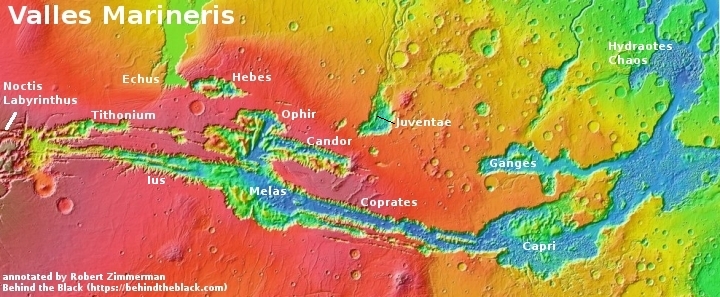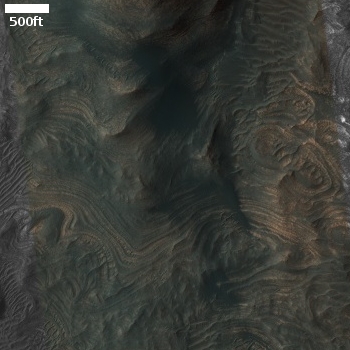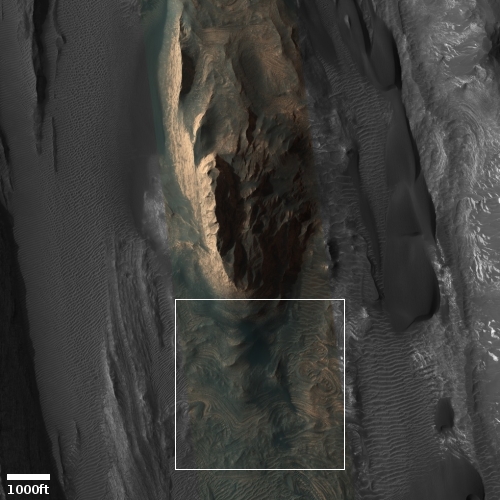How did sand dunes get to the top of a Martian mesa?
Cool image time! The photo to the right, cropped and reduced to post here, was taken on January 1, 2022 by the high resolution camera on Mars Reconnaissance Orbiter (MRO) and shows one of the peaks of a 5,000+ foot high mesa inside Juventai Chasma, one of Mars’ deep mostly-enclosed chasms north of Valles Marineris.
I grabbed this picture because its label, “Bedform Change Detection in Juventae Chasma”, suggested something had changed from past photos, probably related to the sand dunes that hug the upper slopes of this peak. Unfortunately, in comparing this image with the earliest high-res image taken by MRO back in February 2018, I could not spot any change, probably because the resolution of the pictures released is not as high as MRO’s raw images.
However, the caption written for that 2018 image tells us where that change has likely occurred:
This image reveals a unique situation where this small dune field occurs along the summit of the large 1-mile-tall [mesa] near the center of Juventae Chasma. The layered [mesa] slopes are far too steep for dunes to climb, and bedform sand is unlikely to come from purely airborne material. Instead, the mound’s summit displays several dark-toned, mantled deposits that are adjacent to the dunes and appear to be eroding into fans of sandy material.
In other words, somewhere in the full resolution image scientists have spotted a change in the bedform sands that make-up these high mountain dunes that hug the peak. Since the data so far has suggested that the source for the sand of these high elevation dunes likely comes from the mesa itself — not from any distant source — any change found will help confirm or disprove that hypothesis.
The white box indicates the area covered by the close-up higher resolution picture below. Also below is an overview map, showing both the location of this mountain in Juventai Chasma as well as Juventai’s location relative to Valles Marineris.


The black line next to Juventai points to the mesa peak, located on the western floor of the chasm. Juventai itself is estimated to be 60 by 150 miles in size.
The section to the right is at the highest resolution generally used by the public. What makes it intriguing are the swirls of layering south and east of the peak. These swirls are very hard to see in the reduced resolution image above.
These layers once again remind us what both the orbiters and rovers are now telling us, that the geological history of Mars is filled with cycles within cycles within cycles, each producing another layer, sometimes thin, sometimes thick, sometimes a thick layer made up of many thinner internal layers. The swirls are the result of erosion only removing some sections while leaving others.
On Christmas Eve 1968 three Americans became the first humans to visit another world. What they did to celebrate was unexpected and profound, and will be remembered throughout all human history. Genesis: the Story of Apollo 8, Robert Zimmerman's classic history of humanity's first journey to another world, tells that story, and it is now available as both an ebook and an audiobook, both with a foreword by Valerie Anders and a new introduction by Robert Zimmerman.
The print edition can be purchased at Amazon or from any other book seller. If you want an autographed copy the price is $60 for the hardback and $45 for the paperback, plus $8 shipping for each. Go here for purchasing details. The ebook is available everywhere for $5.99 (before discount) at amazon, or direct from my ebook publisher, ebookit. If you buy it from ebookit you don't support the big tech companies and the author gets a bigger cut much sooner.
The audiobook is also available at all these vendors, and is also free with a 30-day trial membership to Audible.
"Not simply about one mission, [Genesis] is also the history of America's quest for the moon... Zimmerman has done a masterful job of tying disparate events together into a solid account of one of America's greatest human triumphs."--San Antonio Express-News
Cool image time! The photo to the right, cropped and reduced to post here, was taken on January 1, 2022 by the high resolution camera on Mars Reconnaissance Orbiter (MRO) and shows one of the peaks of a 5,000+ foot high mesa inside Juventai Chasma, one of Mars’ deep mostly-enclosed chasms north of Valles Marineris.
I grabbed this picture because its label, “Bedform Change Detection in Juventae Chasma”, suggested something had changed from past photos, probably related to the sand dunes that hug the upper slopes of this peak. Unfortunately, in comparing this image with the earliest high-res image taken by MRO back in February 2018, I could not spot any change, probably because the resolution of the pictures released is not as high as MRO’s raw images.
However, the caption written for that 2018 image tells us where that change has likely occurred:
This image reveals a unique situation where this small dune field occurs along the summit of the large 1-mile-tall [mesa] near the center of Juventae Chasma. The layered [mesa] slopes are far too steep for dunes to climb, and bedform sand is unlikely to come from purely airborne material. Instead, the mound’s summit displays several dark-toned, mantled deposits that are adjacent to the dunes and appear to be eroding into fans of sandy material.
In other words, somewhere in the full resolution image scientists have spotted a change in the bedform sands that make-up these high mountain dunes that hug the peak. Since the data so far has suggested that the source for the sand of these high elevation dunes likely comes from the mesa itself — not from any distant source — any change found will help confirm or disprove that hypothesis.
The white box indicates the area covered by the close-up higher resolution picture below. Also below is an overview map, showing both the location of this mountain in Juventai Chasma as well as Juventai’s location relative to Valles Marineris.


The black line next to Juventai points to the mesa peak, located on the western floor of the chasm. Juventai itself is estimated to be 60 by 150 miles in size.
The section to the right is at the highest resolution generally used by the public. What makes it intriguing are the swirls of layering south and east of the peak. These swirls are very hard to see in the reduced resolution image above.
These layers once again remind us what both the orbiters and rovers are now telling us, that the geological history of Mars is filled with cycles within cycles within cycles, each producing another layer, sometimes thin, sometimes thick, sometimes a thick layer made up of many thinner internal layers. The swirls are the result of erosion only removing some sections while leaving others.
On Christmas Eve 1968 three Americans became the first humans to visit another world. What they did to celebrate was unexpected and profound, and will be remembered throughout all human history. Genesis: the Story of Apollo 8, Robert Zimmerman's classic history of humanity's first journey to another world, tells that story, and it is now available as both an ebook and an audiobook, both with a foreword by Valerie Anders and a new introduction by Robert Zimmerman.
The print edition can be purchased at Amazon or from any other book seller. If you want an autographed copy the price is $60 for the hardback and $45 for the paperback, plus $8 shipping for each. Go here for purchasing details. The ebook is available everywhere for $5.99 (before discount) at amazon, or direct from my ebook publisher, ebookit. If you buy it from ebookit you don't support the big tech companies and the author gets a bigger cut much sooner.
The audiobook is also available at all these vendors, and is also free with a 30-day trial membership to Audible.
"Not simply about one mission, [Genesis] is also the history of America's quest for the moon... Zimmerman has done a masterful job of tying disparate events together into a solid account of one of America's greatest human triumphs."--San Antonio Express-News



I wonder if the terrain would act like a filter.
When the winds kick up the heavy stuff would either not move or only move to lower points.
The lighter stuff capable of being lifted by the winds would carry higher into the atmosphere and thus only the lightest would be deposited on the highest points.
The top reaches of Mons Olympus should have a good covering of very very fine material.